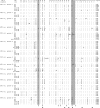HIV-1 dynamics and coreceptor usage in Maraviroc-treated patients with ongoing replication
- PMID: 23208718
- PMCID: PMC3553713
- DOI: 10.1128/AAC.02159-12
HIV-1 dynamics and coreceptor usage in Maraviroc-treated patients with ongoing replication
Abstract
There is evidence that HIV-1 evolution under maraviroc (MVC) pressure can lead to the selection of either X4-tropic variants and/or R5-tropic, MVC-resistant isolates. However, the viral dynamics of HIV-1 variants in patients with virological failure (VF) on MVC-containing regimens remain poorly studied. Here, we investigated the V3 loop evolution of HIV-1 on MVC in relation to coreceptor usage and the nature of HIV-1 quasispecies before MVC therapy using bulk population sequences and ultradeep sequencing. The majority of patients had no detectable minority X4 variant at baseline. The evolution of tropism was followed up until VF and showed three possibilities for viral evolution in these patients: emergence of preexisting X4 variants, de novo selection of R5 variants presenting V3 loop mutations, or replication of R5 variants without selection of known mutations.
Figures


References
-
- MacArthur RD, Novak RM. 2008. Reviews of anti-infective agents: maraviroc: the first of a new class of antiretroviral agents. Clin. Infect. Dis. 47:236–241 - PubMed
-
- Safarian D, Carnec X, Tsamis F, Kajumo F, Dragic T. 2006. An anti-CCR5 monoclonal antibody and small molecule CCR5 antagonists synergize by inhibiting different stages of human immunodeficiency virus type 1 entry. Virology 352:477–484 - PubMed
-
- Gulick RM, Lalezari J, Goodrich J, Clumeck N, DeJesus E, Horban A, Nadler J, Clotet B, Karlsson A, Wohlfeiler M, Montana JB, McHale M, Sullivan J, Ridgway C, Felstead S, Dunne MW, van der Ryst E, Mayer H. 2008. Maraviroc for previously treated patients with R5 HIV-1 infection. N. Engl. J. Med. 359:1429–1441 - PMC - PubMed
Publication types
MeSH terms
Substances
LinkOut - more resources
Full Text Sources
Medical

